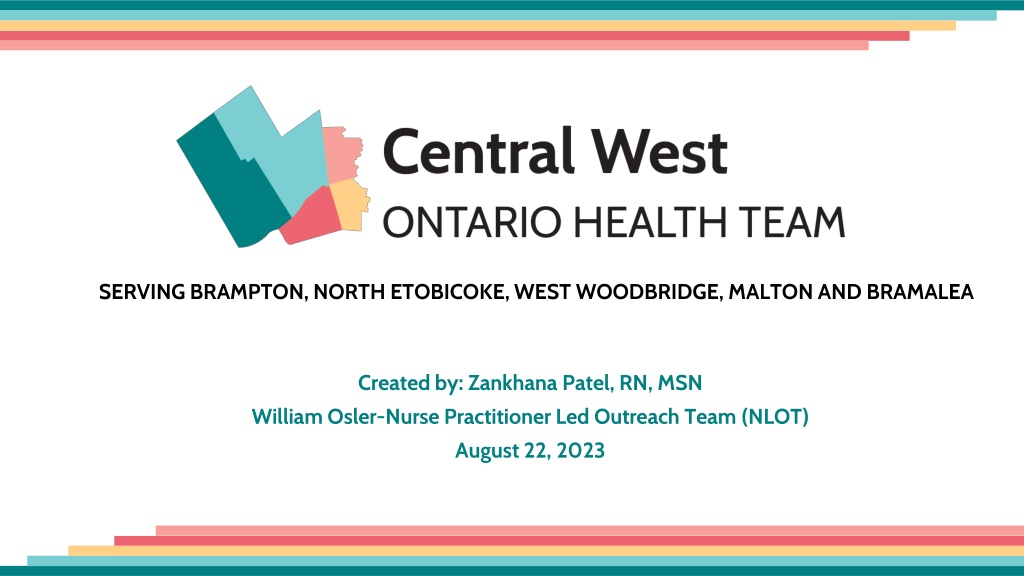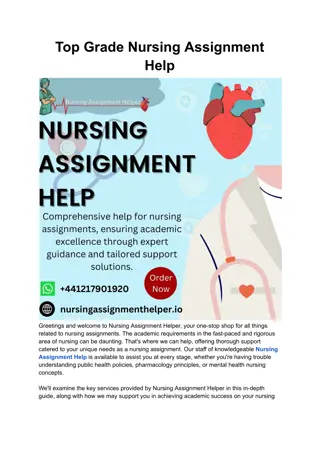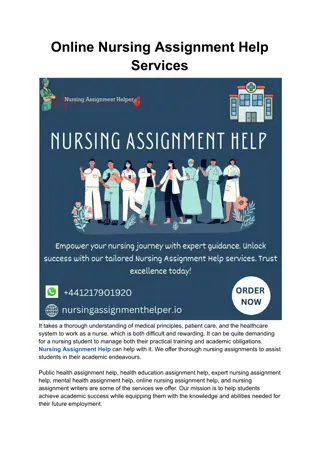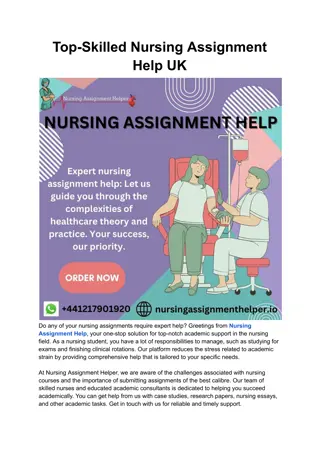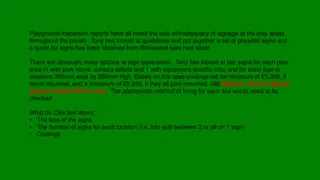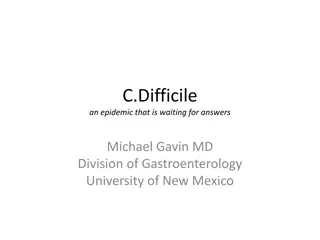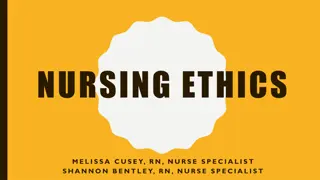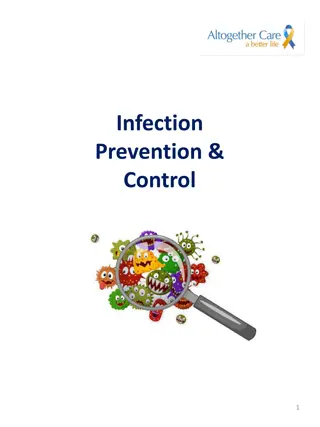Understanding Infection: Causes, Signs, and Nursing Management
Learn about the definition of infection, common causes, general and specific signs and symptoms, nursing assessment for foot ulcers and pressure injuries, as well as nursing interventions for infection prevention and management. Dive into the stages of infection, general and specific signs and symptoms, and get insights on how to identify, treat, and manage infections effectively.
Download Presentation

Please find below an Image/Link to download the presentation.
The content on the website is provided AS IS for your information and personal use only. It may not be sold, licensed, or shared on other websites without obtaining consent from the author. Download presentation by click this link. If you encounter any issues during the download, it is possible that the publisher has removed the file from their server.
E N D
Presentation Transcript
SERVING BRAMPTON, NORTH ETOBICOKE, WEST WOODBRIDGE, MALTON AND BRAMALEA Created by: Zankhana Patel, RN, MSN William Osler-Nurse Practitioner Led Outreach Team (NLOT) August 22, 2023
SERVING BRAMPTON, NORTH ETOBICOKE, WEST WOODBRIDGE, MALTON AND BRAMALEA Clinical Signs & Symptoms of Infection: Nursing Management
Learning Objectives To identify the definition of infection To outline common causes of infection To discuss the general and specific S & S of infection To discuss nursing assessment for foot ulcers and pressure injuries To review nursing interventions related to prevention and management of infection
What is Infection? An infection occurs when microorganism (i.e. virus, bacteria, fungus) enter a person s body and multiply, causing illness, organ and tissue damage, or disease Result of an interaction between a susceptible host and infectious agent A clinical syndrome caused by the invasion and multiplication of a pathogen in the body.
General S & S of Infection Nursing Assessment Malaise/fatigue (i.e., a feeling of discomfort, or lack of well-being), Headache Chills & fever [body temperature over 38 C : low grade or under 36; >38.5 C: high grade) Lack of appetite HR > 100 beats/minute, RR> 20/min, low BP < 90/60 mmHg Hyperglycemia Pain Joint aches Rash Lab results: Elevated WBCs, C-reactive protein (CRP), Erythrocyte sedimentation rate (ESR), +ve wound/tissue culture (Registered Nurses Association of Ontario [RNAO], 2016).
Specific S & S of Infection Nursing Assessment Wound or Incision: Redness, warmth, swelling, drainage from a wound Yellow or green drainage (i.e., purulent drainage) Neurological: Observe for mental status & changes in behaviour (i.e. New confusion and/or worsening level of consciousness). Respiratory: Sore throat, new cough and/or productive cough of purulent sputum, SOB, RR> 20/min Genitourinary: Malodorous, cloudy, or bloody urine, with increased frequency, urgency, or pain with urination Gastrointestinal: Loss of appetite, nausea, vomiting, or diarrhea. Discolored or unusually malodorous feces. (RNAO, 2016).
Assessment of Foot Ulcers: S & S of Infection Non-limb-threatening Infection Superficial infection Non-healing Bright red granulation tissue Friable and exuberant granulation New areas of breakdown or necrosis Increased exudates Bridging of soft tissue and the epithelium Foul odour from discharge (RNAO, 2016).
Assessment of Foot Ulcers: S & S of Infection Limb-threatening Infection Deep wound infection Pain Swelling, induration Erythema (> 2 cm) Wound breakdown Increased size or satellite areas undermining or tunneling Probing to bone Anorexia Flu-like symptoms Erratic glucose levels (RNAO, 2016).
Assessment of Foot Ulcers: S & S of Infection Systemic infection In addition to deep wound infection symptoms: Fever Rigour Chills Hypotension (BP < 90/60 mmHg) Tachycardia HR > 100 bpm Hypoxia SpO2 < 90% Multi-organ failure related to sepsis (RNAO, 2016).
Situation: What is the concern? Background: What do you know? Physician/NP Communication: SBAR Action/Assessment: What did you do? Assessment Interventions Recommendation/Request: What help is needed?
What is Sepsis? Severe infection spreading via the bloodstream Bacterial, Viral; Fungal Infections in lungs, kidney, skin, abdomen etc. can spread and lead to sepsis If suspected/confirmed: It is CRUCIAL to monitor closely for signs & symptoms of rapid progression Nurse is often the first to recognize sepsis as well as risk of sepsis Early recognition and rapid response are essential for successful treatment of sepsis
Stages of Sepsis 3. Severe Sepsis oPrevious criteria oPlus, S&S of organ failure Lungs: Acute respiratory distress Brain: acutely altered mental status, GCS<15 Liver: elevated LFT & bilirubin Kidney: elevated Cr, low urine output (despite fluid) Heart: Hypotension, drop from baseline BP >40mmHg Hematologic: decreased platelet, increased INR (without anticoagulation) 1. Systemic Inflammatory Response Syndrome (SIRS) oSystemic inflammation o 2 of the following: Temp >38 or <36 HR >90 RR >20 Elevated wbc or low wbc Sepsis oPrevious criteria oPlus probable or confirmed infection 2.
4. Septic Shock Previous criteria Plus hypotension (which doesn t respond to fluid resuscitation) High mortality rate
Sepsis: Signs and Symptoms Fever or very low body temperature Temperature greater than 38 C or lower than 36 C Chills/Rigors Increased heart rate Heart rate greater then 90bpm/min Increased respiratory rate Respiratory rate greater than 20bpm/min Severe Hypotension Systolic blood pressure lower than 90mmHg Hypoxia SpO2 < 90% Decreased or absent urine output New onset of confusion Rash Elevated WBCs or low WBCs SEPSIS S: Slurred speech or confusion E: Extreme shivering or fever P: Passing NO urine all day S: Shortness of breath I: It feels like you re going to die S: Skin mottled or discoloured
Assessment for Infection: Pressure Injuries People with pressure injuries are at increased risk for infection. Assess pressure injuries for signs and symptoms of infection (i.e., superficial critical colonization/localized infection or deep and surrounding infection/systemic infection) on initial examination and at every visit, including at every dressing change. Regular pressure injury assessments allow interprofessional teams to identify and treat wound infections while they are still in the early stages of development. An assessment of the presence and degree of the person s pain must be included as a component of any assessment for infection. To guide the use of appropriate anti-infective agents, it is important to obtain a semi-quantitative wound culture swab (or tissue culture, in appropriate settings). Prior to obtaining a sample, the wound bed should be cleaned of debris. Tissue cultures and swabs should only be done once a clinician has reviewed the person s wound history, conducted a physical exam of the pressure injury, and assessed the wound for signs of symptoms of infection. (RNAO, 2016).
Nursing Interventions General head to toe assessment Pharmacological (antibacterial, antiviral, or anti-fungal agents) Glycemic control Diet high in protein and vitamin C (promotes healing) Pain management Appropriate wound dressings Frequent vital signs monitoring Adequate hydration
Infection Prevention Strategies o Strict compliance with hand hygiene, universal and isolation precautions o Minimizing the risk of catheter contamination and duration o Meticulous skin care o Education to staff o Surveillance of nosocomial infection rates o Prophylactic antibiotic therapy may be given
References Registered Nurses Association of Ontario (2016). Clinical Best Practice Guidelines: Assessment and Management of Pressure Injuries for the Interprofessional Team. Retrieved on August 17, 2023 from Pressure_Injuries_BPG.pdf
